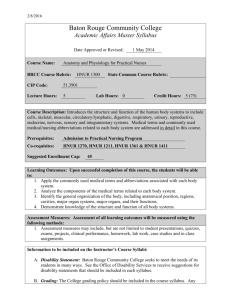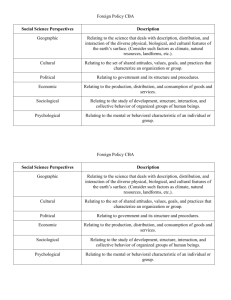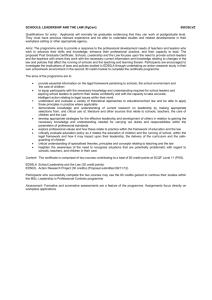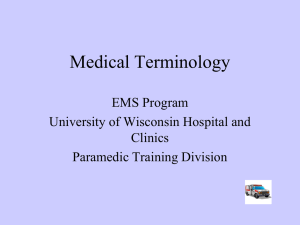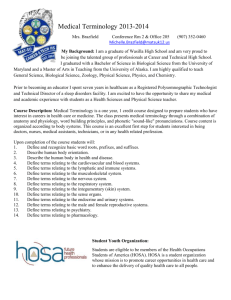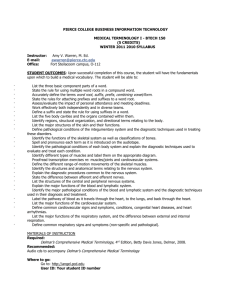MEDICAL TERMINOLOGY
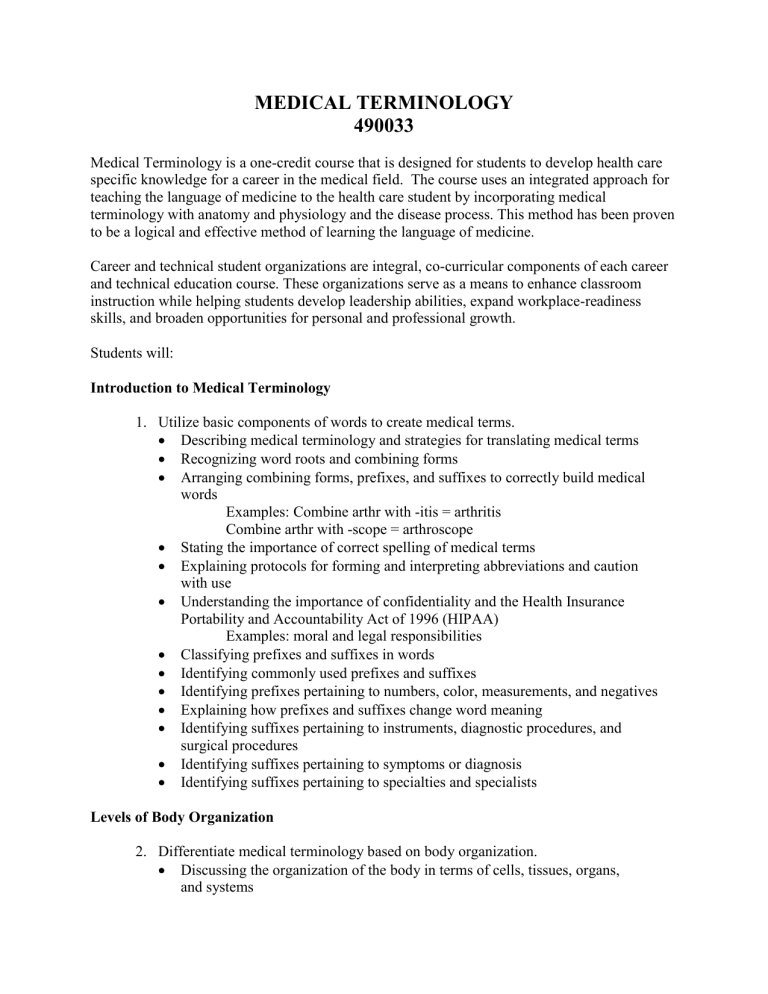
MEDICAL TERMINOLOGY
490033
Medical Terminology is a one-credit course that is designed for students to develop health care specific knowledge for a career in the medical field. The course uses an integrated approach for teaching the language of medicine to the health care student by incorporating medical terminology with anatomy and physiology and the disease process. This method has been proven to be a logical and effective method of learning the language of medicine.
Career and technical student organizations are integral, co-curricular components of each career and technical education course. These organizations serve as a means to enhance classroom instruction while helping students develop leadership abilities, expand workplace-readiness skills, and broaden opportunities for personal and professional growth.
Students will:
Introduction to Medical Terminology
1.
Utilize basic components of words to create medical terms.
Describing medical terminology and strategies for translating medical terms
Recognizing word roots and combining forms
Arranging combining forms, prefixes, and suffixes to correctly build medical words
Examples: Combine arthr with -itis = arthritis
Combine arthr with -scope = arthroscope
Stating the importance of correct spelling of medical terms
Explaining protocols for forming and interpreting abbreviations and caution with use
Understanding the importance of confidentiality and the Health Insurance
Portability and Accountability Act of 1996 (HIPAA)
Examples: moral and legal responsibilities
Classifying prefixes and suffixes in words
Identifying commonly used prefixes and suffixes
Identifying prefixes pertaining to numbers, color, measurements, and negatives
Explaining how prefixes and suffixes change word meaning
Identifying suffixes pertaining to instruments, diagnostic procedures, and surgical procedures
Identifying suffixes pertaining to symptoms or diagnosis
Identifying suffixes pertaining to specialties and specialists
Levels of Body Organization
2.
Differentiate medical terminology based on body organization.
Discussing the organization of the body in terms of cells, tissues, organs, and systems
Locating body planes and body regions
Identifying the body cavities and organs contained within those cavities
Distinguishing the anatomical and clinical divisions of the abdomen
Examples: Anatomical Divisions - Right Hypochondriac, Epigastric, Left
Hypochondriac, Right Lumbar, Umbilical, Left Lumbar, Right Iliac,
Hypogastric, Left Iliac
Clinical Divisions - Right Upper Quadrant (RUQ), Right Lower Quadrant
(RLQ), Left Upper Quadrant (LUQ), Left Lower Quadrant (LLQ)
Analyzing directional and positional terms
Examples: Superior versus inferior
The adrenal glands are superior to the kidneys
The intestine is inferior to the heart
Interpreting abbreviations associated with body organization
Integumentary System
3.
Demonstrate understanding of medical terminology relating to the anatomical structures of the integumentary system.
Identifying the appropriate combining form(s) for terms relating to the integumentary system
Interpreting the abbreviations common to the integumentary system
Examining anatomical structures relating to the integumentary system
Describing diagnostic procedures common to the integumentary system
Examples: Biopsy (bx), exfoliative cytology, frozen section, and fungal scrapings
Explaining therapeutic procedures common to the integumentary system
Examples: skin graft, cauterization, debridement, electrocautery, Incision and Drainage (I&D), dermabrasion, and liposuction
Investigating pathological conditions of the integumentary system
Examples: laceration, macule, pustule, ulcer, abscess, acne rosacea, basal cell carcinoma, burn, cellulitis, decubitus ulcer, malignant melanoma, pediculosis, varicella, and alopecia
Musculoskeletal System
4.
Demonstrate understanding of medical terminology relating to the anatomical structures of the musculoskeletal system.
Identifying the appropriate combining form(s) for terms relating to the musculoskeletal system
Interpreting the abbreviations common to the musculoskeletal system
Examining anatomical structures relating to the musculoskeletal system
Describing diagnostic procedures common to the musculoskeletal system
Examples: arthrography, bone scan, dual-energy absorptiometry, myelography, radiography, and arthroscopy
Explaining therapeutic procedures common to the musculoskeletal system
Examples: amputation, arthroscopic surgery, bone graft, laminectomy, total hip arthroplasty, fixation, reduction, and traction
Investigating pathological conditions of the musculoskeletal system
Examples: closed fracture, compound fracture, stress fracture, Ewing’s sarcoma, osteoporosis, scoliosis, osteoarthritis, rheumatoid arthritis, sprain, and Systemic Lupus Erythematosus (SLE)
Cardiovascular System
5.
Demonstrate understanding of medical terminology relating to the anatomical structures of the cardiovascular system.
Identifying the appropriate combining form(s) for terms relating to the cardiovascular system
Interpreting the abbreviations common to the cardiovascular system
Identifying anatomical structures relating to the cardiovascular system
Describing diagnostic procedures common to the cardiovascular system
Examples: cardiac enzymes, angiography, echocardiography, cardiac catheterization, electrocardiography, and stress testing
Explaining therapeutic procedures common to the cardiovascular system
Examples: defibrillation, Cardiopulmonary Resuscitation (CPR), thrombolytic therapy, and embolectomy
Investigating pathological conditions of the cardiovascular system
Examples: arrhythmia, bundle branch block, cardiac arrest, Congenital
Septal Defect (CSD), Congestive Heart Failure (CHF), Coronary Artery
Disease (CAD), Myocardial Infarction (MI), aneurysm, arteriosclerosis, hypertension, hypotension, and thrombus
Identifying the pathway of blood as it travels through the heart, to the lungs, and back through the heart
Blood, Lymphatic, and Immune Systems
6.
Demonstrate understanding of medical terminology relating to the anatomical structures of the blood, lymphatic, and immune system.
Identifying the appropriate combining form(s) for terms relating to the blood, lymphatic, and immune systems
Interpreting the abbreviations common to the blood, lymphatic, and immune systems
Identifying anatomical structures relating to the blood, lymphatic, and immune systems
Describing diagnostic procedures common to the blood, lymphatic, and immune systems
Examples: Blood - Complete Blood Count (CBC), Erythrocyte
Sedimentation Rate (ESR), and Hemoglobin (Hgb)
Lymphatic and Immune - Enzyme-Linked Immunosorbent Assay
(ELISA), Western Blot, lymphangiography, Monospot, and scratch test
Explaining therapeutic procedures common to the blood, lymphatic, and immune systems
Examples: Blood - blood transfusion, Bone Marrow Transplant (BMT) homologous transfusion, and plasmapheresis
Lymphatic and Immune - immunotherapy, vaccination, and lymphadenectomy
Investigating pathological conditions of the blood, lymphatic, and immune systems
Examples: Blood - hemophilia, hyperlipidemia, anemia, sickle cell anemia, thalassemia, and leukemia
Lymphatic - Hodgkin’s disease, mononucleosis, non-Hodgkin’s lymphoma, lymphadenitis, and elephantiasis
Immune - Acquired Immunodeficiency Syndrome (AIDS), Kaposi’s
Sarcoma, and Sarcoidosis
Respiratory System
7.
Demonstrate understanding of medical terminology relating to the anatomical structures of the respiratory system.
Identifying the appropriate combining form(s) for terms relating to the respiratory system
Interpreting the abbreviations common to the respiratory system
Identifying anatomical structures relating to the respiratory system
Describing diagnostic procedures common to the respiratory system
Examples: Arterial Blood Gases (ABGs), chest x-ray, bronchoscopy, oximetry, Pulmonary Function Test (PFT), and tuberculin skin tests
Explaining therapeutic procedures common to the respiratory system
Examples: endotracheal intubation, postural drainage, supplemental oxygen therapy, ventilator, thoracentesis, and tracheostomy
Investigating pathological conditions of the respiratory system
Examples: croup, pertussis, asthma, bronchogenic carcinoma, Adult
Respiratory Distress Syndrome (ARDS), Chronic Obstructive Pulmonary
Disease (COPD), Sudden Infant Death Syndrome (SIDS), and tuberculosis
Describing the process of breathing and identify the pathway of air as it travels from the nose to the capillaries of the lungs
Digestive System
8.
Demonstrate understanding of medical terminology relating to the anatomical structures of the digestive system.
Identifying the appropriate combining form(s) for terms relating to the digestive system
Interpreting the abbreviations common to the digestive system
Identifying anatomical structures relating to the digestive system
Describing diagnostic procedures common to the digestive system
Examples: Fecal Occult Blood Test (FOBT), Ova and Parasites (O&P), lower gastrointestinal series, and colonoscopy
Explaining therapeutic procedures common to the digestive system
Examples: Nasogastric Tube (NG Tube), Total Parenteral Nutrition
(TPN), colostomy, gastric stapling, and exploratory laparotomy
Investigating pathological conditions of the digestive system
Examples: cleft palate, periodontal disease, hiatal hernia, peptic ulcer,
Crohn’s disease, diverticulitis, irritable bowel syndrome, hepatitis
Urinary System
9.
Demonstrate understanding of medical terminology relating to the anatomical structures of the urinary system.
Identifying the appropriate combining form(s) for terms relating to the urinary system
Interpreting the abbreviations common to the urinary system
Identifying anatomical structures relating to the urinary system
Describing diagnostic procedures common to the urinary system
Examples: Blood Urea Nitrogen (BUN), Creatinine Clearance (CC),
Urinalysis (U/A), and Urine Culture and Sensitivity (C&S)
Explaining therapeutic procedures common to the urinary system
Examples: catheterization, Hemodialysis (HD), peritoneal dialysis, lithotripsy, nephrolithotomy, and renal transplant
Investigating pathological conditions common to the urinary system
Examples: diabetic nephropathy, pyelonephritis, Wilm’s tumor, bladder cancer, cystocele, neurogenic bladder, and Urinary Tract Infection (UTI)
Female Reproductive System
10.
Demonstrate understanding of medical terminology relating to the anatomical structures of the female reproductive system.
Identifying the appropriate combining form(s) for terms relating to the female reproductive system
Interpreting the abbreviations common to the female reproductive system
Identifying anatomical structures relating to the female reproductive system
Describing diagnostic procedures common to the female reproductive system
Examples: Papanicolaou Smear, pregnancy test, mammography, colposcopy, amniocentesis, cervical biopsy, and pelvic examination
Explaining therapeutic procedures common to the female reproductive system
Examples: cesarean section (C-section), Dilation and Curettage (D & C), radical mastectomy, and tubal ligation
Investigating pathological conditions of the female reproductive system
Examples: ovarian carcinoma, fibroid tumor, cervical cancer, prolapsed uterus, candidiasis, endometriosis, Pelvic Inflammatory Disease (PID), breast cancer, and sexually transmitted diseases
Male Reproductive System
11.
Demonstrate understanding of medical terminology relating to the anatomical structures of the male reproductive system.
Identifying the appropriate combining form(s) for terms relating to the male reproductive system
Interpreting the abbreviations common to the male reproductive system
Identifying anatomical structures of the male reproductive system
Describing diagnostic procedures common to the male reproductive system
Examples: Prostate-Specific Antigen (PSA) and rectal exam
Explaining therapeutic procedures common to the male reproductive system
Examples: circumcision, transurethral resection of the prostate, and vasectomy
Investigating pathological conditions of the male reproductive system
Examples: cryptorchidism, hydrocele, testicular carcinoma, prostate cancer, hypospadias, and sexually transmitted diseases
Endocrine System
12.
Demonstrate understanding of medical terminology relating to the anatomical structures of the endocrine system.
Identifying the appropriate combining form(s) for terms relating to the endocrine system
Interpreting the abbreviations common to the endocrine system
Identifying anatomical structures relating to the endocrine system
Describing diagnostic procedures common to the endocrine system
Examples: blood serum test, fasting blood sugar, Glucose Tolerance Test
(GTT), Thyroid Function Test (TFT), thyroid echogram, and thyroid scan
Explaining therapeutic procedures common to the endocrine system
Examples: chemical thyroidectomy, hormone replacement therapy, and laparoscopic adrenalectomy
Investigating pathological conditions of the endocrine system
Examples: Addison’s disease, Cushing’s syndrome, diabetes mellitus, diabetic retinopathy, ketoacidosis, non-insulin dependent diabetes mellitus, Graves’ disease, Hashimoto’s disease, and adenocarcinoma
Nervous System
13.
Demonstrate understanding of medical terminology relating to the anatomical structures of the nervous system.
Identifying the appropriate combining form(s) for terms relating to the nervous system
Interpreting the abbreviations common to the nervous system
Identifying anatomical structures relating to the nervous system
Describing diagnostic procedures common to the nervous system
Examples: cerebrospinal fluid analysis, brain scan, echoencephalography, myelography, Electroencephalography (EEG), and Lumbar Puncture (LP)
Explaining therapeutic procedures common to the nervous system
Examples: nerve block, carotid endarterectomy, cerebrospinal fluid shunts, and laminectomy
Investigating pathological conditions common to the nervous system
Examples: absence seizures, Alzheimer’s disease, brain tumor, cerebral aneurysm, Cerebrovascular Accident (CVA), concussion, migraine,
Parkinson’s disease, Transient Ischemic Attacks (TIA), and shingles
Special Senses System
14.
Demonstrate understanding of medical terminology relating to the anatomical structures of the special senses system.
Identifying the appropriate combining form(s) for terms relating to the special senses system
Interpreting the abbreviations common to the special senses system
Examining anatomical structures relating to the special senses system
Describing diagnostic procedures common to the special senses system
Examples: Eye - ophthalmoscopy, fluorescein staining, Snellen chart, and visual acuity test
Ear - audiometry, Rinne and Weber tuning-fork tests, otoscopy, and tympanometry
Explaining therapeutic procedures common to the special senses system
Examples: Eye - keratoplasty, laser photocoagulation, radial keratotomy, and strabotomy
Ear - hearing aid, cochlear implant, myringotomy, pressure equalizing tube, and stapedectomy
Investigating pathological conditions of the special senses system
Examples: Eye - astigmatism, corneal abrasion, glaucoma, macular degeneration, myopia, retinal detachment, retinoblastoma, trachoma, hordeolum, strabismus, and nystagmus
Ear - anacusis, ceruminoma, otitis externa, otitis media, otosclerosis, acoustic neuroma, labyrinthitis, and Meniere’s disease
